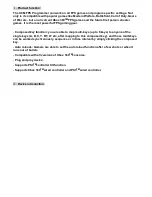
4
E3F2-
@
Z
Dimensions
Precautions
The E3F2 Photoelectric Sensor is not a safety component for ensur-
ing the safety of people which is defined in EC directive (91/368/
EEC) and covered by separate European standards or by any other
regulations or standards.
Degree of protection
The E3F2 photoelectric sensors have a degree of protection rated
with IP67. In this case, the sensors have passed the OMRON heat
shock test before the IP67-test of IEC 60529 (submersion at 1m
water depth for 30 min). Afterwards the sensors have been tested
according to the OMRON waterproof test.
Heat shock:
Alternating, fast temperature changes between -25 °C
and +55 °C are executed for 5 cycles and 1 hour for
each temperature. Function and isolation are checked.
Water proof:
The sensors are submerged alternating in water of
+2 °C and +55 °C. 20 cycles with 1 hour for each tem-
perature are executed. Function, water tightness and
electrical isolation are checked.
Do not expose the photoelectric sensor to excessive shock during
installation, keeping within IP 67 standards.
Wiring
If the input/output lines of the photoelectric sensor are placed in the
same conduit or duct as power lines or high-voltage lines, the photo-
electric sensor could be induced to malfunction, or even be damaged
by electrical noise. Separate the wiring, or use shielded lines as
input/output lines to the photoelectric sensor.
Do not connect the black wire to the brown wire without a load. Direct
connection of these wires may damage the photoelectric sensor (AC
switching type).
When using the photoelectric sensor in the vicinity of an inverter
motor, ensure to connect the protective earth ground wire of the
motor to earth. Failure to ground the motor may result in malfunction
of the sensor.
When you use the photoelectric sensor at temperatures exceeding
45 °C, the load current must be within the described values as
shown in the figure below.
Installation
Do not exceed a torque of
• 2.0 Nm ( 20 kgf cm) when tightening mounting nuts for plastic mod-
els
• 20.0 Nm (200 kgf cm) when tightening mounting nuts for metal mod-
els
Cable type
Without potentiometer
E3F2-3Z
#
E3F2-R2Z
#
E3F2-DS10Z
#
-N
16.8 dia.
24
3.1
optical zone
22
90
67.3
62
M18 x 1 6g
5 dia.
8
3.1
Light indicator
Black
Brown
Blue
Load
Sensor
24 to 240 VAC
Operating temperature (˚C)
200
130
55
45
0
Load current (mA)
In the interest of product improvement, specifications are subject to change without notice.
Cat. No. E
43E-EN
-0
1
OMRON EUROPE B.V.
Wegalaan 67-69,
NL-2132 JD, Hoofddorp,
The Netherlands
Phone: +31 23 568 13 00
Fax:
+31 23 568 13 88
www.eu.omron.com






















